
Revenue stamps of Jamaica were first issued in 1855. There were various types of fiscal stamps for different taxes. [1]

Revenue stamps of Jamaica were first issued in 1855. There were various types of fiscal stamps for different taxes. [1]
Jamaica's first revenue stamps were issued in 1855, and they bore the colony's coat of arms. The initial set consisted of two values: 1½d and 3d, and it was imperforate. In 1857 the two values were re-issued with perforations and in 1874 the 3d was issued with a watermark. In 1858, three high values of 1/-, 5/- and 10/- were issued portraying Queen Victoria as well as the coat of arms. In 1865, a new 1d value again portraying the Queen was issued. This exists with three different watermarks. [2]
In 1887, these revenue stamps became valid for postal use. Hence they are regarded as postal fiscals and are listed in SG catalogues. [3]
Jamaica issued many embossed revenue stamps, which were either printed in large sheets to be used as adhesive revenue stamps, or as directly embossed impressed duty stamps. Adhesive issues were those of the United Kingdom overprinted JAMAICA in black. These exist in various colours, formats and sizes. Adhesive embossed issues were first issued in 1898 and continued to be used until about 1959. Many different die letters are known for these issues. [4] [5]
Directly impressed duty stamps were also used. These were either simply embossed on the document in a colourless die, or later they used a vermilion impressed die. Colourless issues were used from 1804 to 1921, and vermilion ones were used from the 1890s to the 1970s.
Jamaica issued many stamps for judicial purposes. The first issue consisted of Queen Victoria postage stamps overprinted with a large JUDICIAL in bold sans-serif capitals in 1898. This set was reissued with a different watermark in 1908. Similar issues followed in the following years, with the portrait being changed to that of King George V (1913), King George VI (1938) and Queen Elizabeth II (1953). In some cases, the stamps were from specially printed sheets which were never issued without the overprint. These include all of the stamps bearing the portraits of King George VI or Queen Elizabeth II. In 1969 the Queen Elizabeth II set was reissued denominated in decimal currency, and these remained in use until the 1970s. [2]
The Coffee Industry Board of Jamaica was set up in June 1950 to expand the coffee industry. It issued various stamps to pay the levy on roasted or instant coffee from when it was formed until the 1970s. [2]
In March 1961, a set of stamps was prepared for the Jamaica Pensions Authority however the order was cancelled prior to printing. In 1965 a set of two values was issued for this purpose, simply inscribed National Insurance without any indication of the country. These were denominated in pre-decimal currency, at 3/- and 4/-, but after the Jamaican dollar was adopted in 1969 they continued to be used as 30c or 40c stamps respectively. [1] Between 1976 and 1981 new stamps similar to the previous design were issued but inscribed Social Security Jamaica. These remained in use for many years, and in the 2000s new values have appeared with elliptical perforations. [2]

Revenue stamps of Malta were first issued in 1899, when the islands were a British colony. From that year to 1912, all revenue issues were postage stamps overprinted accordingly, that was either done locally or by De La Rue in London. Postage stamps also became valid for fiscal use in 1913, so no new revenues were issued until 1926–30, when a series of key type stamps depicting King George V were issued. These exist unappropriated for use as general-duty revenues, or with additional inscriptions indicating a specific use; Applications, Contracts, Registers or Stocks & Shares. The only other revenues after this series were £1 stamps depicting George VI and Elizabeth II. Postage stamps remained valid for fiscal use until at least the 1980s.
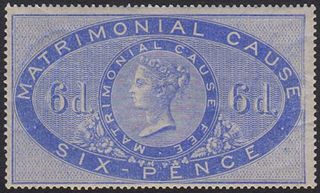
Revenue stamps of the United Kingdom refer to the various revenue or fiscal stamps, whether adhesive, directly embossed or otherwise, which were issued by and used in the Kingdom of England, the Kingdom of Great Britain, the United Kingdom of Great Britain and Ireland and the United Kingdom of Great Britain and Northern Ireland, from the late 17th century to the present day.
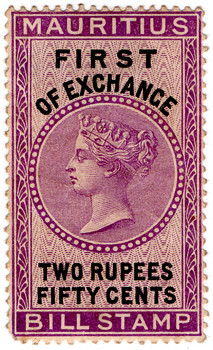
Mauritius issued revenue stamps from 1 March 1869 to 1904. There were various types of fiscal stamps for different uses.
The Australian state of Western Australia issued revenue stamps from 1881 to 1973. There were various types for different taxes.

The Australian state of Victoria issued revenue stamps from 1870 to around 2000. There were various types for different taxes.
The Australian State of Tasmania issued adhesive revenue stamps from 1863 to 1998, although impressed stamps had appeared briefly in the 1820s. There were general revenue and stamp duty issues, as well as a number of specific issues for various taxes.

The island of Cyprus first issued revenue stamps in 1878 and continues to do so to this day. The Turkish Republic of Northern Cyprus also issues its own revenue stamps.

Trinidad and Tobago, formerly divided as two separate colonies, issued revenue stamps from 1879 to around 1991.

Revenue stamps of British Guiana refer to the various revenue or fiscal stamps, whether adhesive or directly embossed, which were issued by British Guiana prior to the colony's independence as Guyana in 1966. Between the 1860s and 1890s, the colony issued Inland Revenue and Summary Jurisdiction stamps, while revenue stamps and dual-purpose postage and revenue stamps were issued during the late 19th and 20th centuries. In around the 1890s or 1900s, British Guiana possibly issued stamps for taxes on medicine and matches, but it is unclear if these were actually issued. Guyana continued to issue its own revenue stamps after independence.
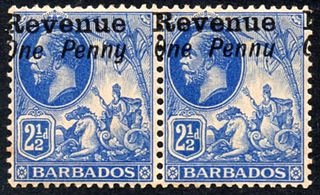
The island of Barbados first issued revenue stamps in 1916. There were various types of fiscal stamps for different taxes.
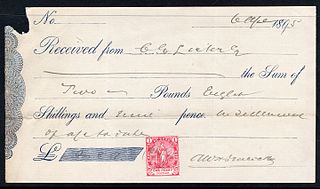
Cape of Good Hope issued revenue stamps from 1864 to 1961. There were a number of different stamps for several taxes.

New Zealand first issued revenue stamps on 1 January 1867 and their general use continued until the early 1950s. The only Revenue Stamp series still in use today is the Game Bird Habitat stamp which is used for payment of the Gun License for the duck shooting season which begins the first weekend of May. There were various types of fiscal stamps for different taxes.

Hong Kong issued revenue stamps from 1867 to the 1990s, both when it was a British colony as well as when it was under Japanese occupation.
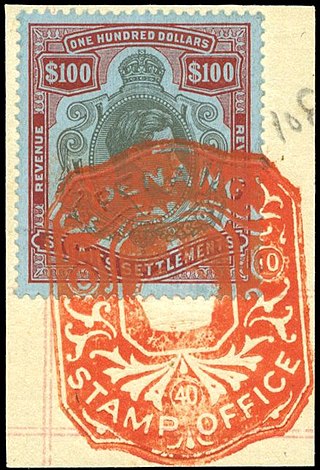
Malaysia first issued revenue stamps as the Straits Settlements in 1863, and continues to do so to this day. Over the years, a number of entities in modern Malaysia have issued revenue stamps.

Uganda issued revenue stamps from around 1896 to the 1990s. There were numerous types of revenue stamps for a variety of taxes and fees.
Revenue stamps of Fiji were first issued in 1871 or 1872, when the Fiji islands were an independent kingdom. The first revenue stamps consisted of postage stamps overprinted with the letter D.
Revenue stamps of Seychelles were first issued in 1893, when the islands were a dependency of the British Crown Colony of Mauritius. The first stamps were Mauritius Internal Revenue stamps depicting Queen Victoria overprinted for use in Seychelles, and Bill stamps were also similarly overprinted. Postage stamps depicting Victoria or Edward VII were overprinted for fiscal use at various points between 1894 and 1904, while surcharges on Bill stamps were made in around 1897–98.
Revenue stamps of Montserrat were first issued in 1866, ten years before the island issued its first postage stamps. The island only issued two different designs of revenue stamps, but postage stamps were widely used for fiscal purposes and are still used as such today.

Revenue stamps of the Leeward Islands were issued by the British Leeward Islands between 1882 and the 1930s. They were used on Antigua, the British Virgin Islands, Dominica, Montserrat and Saint Kitts and Nevis, all of which also issued their own revenue stamps before, during or after they used common issues for the Leeward Islands.
Revenue stamps of Dominica were first issued in 1877, when the island was under British rule. Dominica issued very few revenue stamps, but dual-purpose postage and revenue stamps were widely used for fiscal purposes.